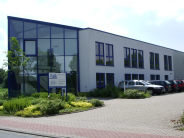Like a computer hard disk: Intelligent material buffers increases the competitiveness
Fast internal logistic chains are fundamental components when it comes to increasing the productivity of a manufacturing company. The trouble-free material flow especially plays a main role in the permanent endeavours to optimize costs when it comes to turning serial elements into customized ex works solutions. One example of the switching from serial production to the
customized manufacturing is sandwich elements for sectional doors.
The sections are manufactured in a continuous production process on
an approx. 100 metre long production plant – referred to as a
Kontilinie. The sandwich-designed sections comprise two hot dip
galvanized steel sheets as an outer skin. The two sides are
connected by PU foam, thereby providing stability and the
insulation of the building at a later date. |
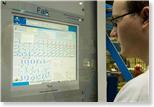 "The virtual warehouse thinks in future terms and creates the possibility of calculating picking processes in advance", is what pleases Alexander Jung a software developer at Falk. |
The warehouse thinks in future terms.
The different stacks of sections are therefore presented in the warehouse visualization in the form of coloured clusters. "This enables various lengths to be visualized very easily", explained Alexander Jung, a software developer at Falk. The conception went to such an extent that the storage jobs were initially simulated. "The virtual warehouse thinks in future terms and creates the possibility of calculating picking processes in advance." The aim here is to initially determine whether storage is possible at all and that before the storage and retrieval machine has received the corresponding travel commands. Falk has also developed a piece of animation software for the virtual warehouse so that it will be possible to quickly recognise the logistic processes which will take place at a later date. It displays the current occupancy of the warehouse and the movements of the storage and retrieval machine which has been designed by Falk. The idea behind this sophisticated system lies in the nature of a sectional door. They are normally individually installed, depending on the length and height. Whilst the cross cutter automatically specifies the section length at the end of the Kontilinie line from the job order, the later door size is determined by a combination of various section heights. These cannot however be manufactured simultaneously in a continuous production process, but when taking expensive retrofitting times into account, they are to be combined from various production batches. This results in an intermediate storage and an job-related picking. |
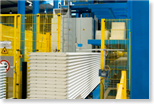 Intermediate storage of finished sections in the internal high bay warehouse. |
Keeping up with the production
The employees enter the items which the storage and retrieval
machine store and retrieve in the high bay warehouse into the
control system. The production orders are also controlled from
here, either by them being directly input or from the SAP system.
"Optimizing processes means that the warehouse system itself
has to work efficiently and fast so as to keep up with the
production", explained Martin Falk, Managing Director of Falk
Steuerungssysteme. |
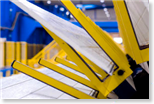 A cooling section receives the sections which have been precisely cut to length. |
The solution
The system defragments itself like a computer hard
disk. |
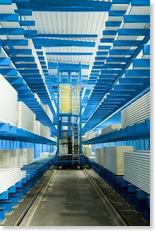 The system is so designed that the storage and retrieval machine only has to travel short distances. |
The author Thorsten Sienk is a freelance specialized journalist
from Bodenwerder. IT&PRODUCTION, 08/2009 |
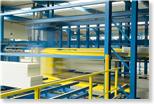 Retrieval of sandwich elements via a bridge for further processing. |
